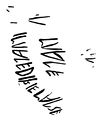AK-1.1
| Inscription | |
|---|---|
| Transliteration: | ?]ṇualeri?ienalṣẹ |
| Original script: | |
|
| |
| Object: | AK-1 rock (stone) (Inscriptions: AK-1.1, AK-1.2, AK-1.3, AK-1.4, AK-1.5, AK-1.6, AK-1.7, AK-1.8, AK-1.9, AK-1.10, AK-1.11, AK-1.12, AK-1.13, AK-1.14, AK-1.15, AK-1.16, AK-1.17, AK-1.18, AK-1.19, AK-1.20, AK-1.21) |
| Position: | bottom, left |
| Orientation: | 90° |
| Script: | North Italic script (Magrè alphabet) |
| Direction of writing: | sinistroverse |
| Letter height: | 77 cm <br /> – 11.5 cm |
| Number of letters: | 15 |
| Number of lines: | 1 |
| Craftsmanship: | engraved |
| Current condition: | damaged |
| Date of inscription: | unknown |
| Date derived from: | |
|
| |
| Type: | prob. votive |
| Language: | Raetic |
| Meaning: | unknown |
|
| |
| Alternative sigla: | TM 653493 |
Images
|
Inscription AK-1.1.
|
Tracing of inscriptions on AK-1 rock.
|
Inscription AK-1.1.
|
Commentary
Not previously published. Examined by TIR in July 2014.
Image in Mandl 2011: Abb. 138 (photo).
Length min. 52 cm; the last character at about 80 cm above the ground. Running downward in a slight curve on a small protrusion on the very left edge of the rock wall, the leftmost one of a group of three (Bildstelle 1, with AK-1.2 and AK-1.3).
Traces of characters can be seen starting from the darker area of rock above the inscription, but no reading can be offered. The first usable group consists of the lower parts of two hastae, the second one possibly ![]() with the angle all but gone.
with the angle all but gone. ![]()
![]() are fairly well legible,
are fairly well legible, ![]()
![]() are unambiguous. Next,
are unambiguous. Next, ![]() with the curve made up of three scratches, followed by
with the curve made up of three scratches, followed by ![]() , is unproblematic. Close to
, is unproblematic. Close to ![]() a clearly visible hasta featuring a doubtful assortment of bars: a half-sized
a clearly visible hasta featuring a doubtful assortment of bars: a half-sized ![]() appears to be attached to its upper end; this making no sense,
appears to be attached to its upper end; this making no sense, ![]() seems the most likely reading epigraphically, but is phonetically suboptimal. The next hasta, though slightly curved, is probably
seems the most likely reading epigraphically, but is phonetically suboptimal. The next hasta, though slightly curved, is probably ![]() ,
, ![]()
![]() are unambiguous. Well legible
are unambiguous. Well legible ![]()
![]() are the last letters which fit onto the face of the protrusion; the last two letters had to be engraved into the concave part below it and are accordingly hard to read. If the last letter is
are the last letters which fit onto the face of the protrusion; the last two letters had to be engraved into the concave part below it and are accordingly hard to read. If the last letter is ![]() , its two lower bars appear to be turned upward.
, its two lower bars appear to be turned upward.
If the reading of the first visible part of the inscription is correct, we can isolate the suffix group -nu-ale and assume a patronym in the pertinentive case, with the base illegible. While it would be convenient to find the same group, amply attested in the rock inscriptions of Steinberg and also a few more times on this rock, at the end of the inscription, we could not contrive, on the day of the examination, to read ![]()
![]()
![]()
![]()
![]() instead of
instead of ![]()
![]()
![]()
![]()
![]() – and not for lack of trying. One would have to dismiss the quite distinct bar of
– and not for lack of trying. One would have to dismiss the quite distinct bar of ![]() as unintentional, assume that the trace of
as unintentional, assume that the trace of ![]() represents the missing part of
represents the missing part of ![]() , and while the two errant bars of doubtful epsilon might be ignored to get
, and while the two errant bars of doubtful epsilon might be ignored to get ![]() , there is no trace of another letter
, there is no trace of another letter ![]() visible after it. As concerns the sequence ri?ie in the middle, the ending would indicate an individual name.
visible after it. As concerns the sequence ri?ie in the middle, the ending would indicate an individual name.
Bibliography
| Mandl 2011 | Franz Mandl, Felsbilder. Österreich – Bayern: Nördliche Kalkalpen [= Anisa – Verein für alpine Forschung 4], Haus im Ennstal: 2011. |
|---|



